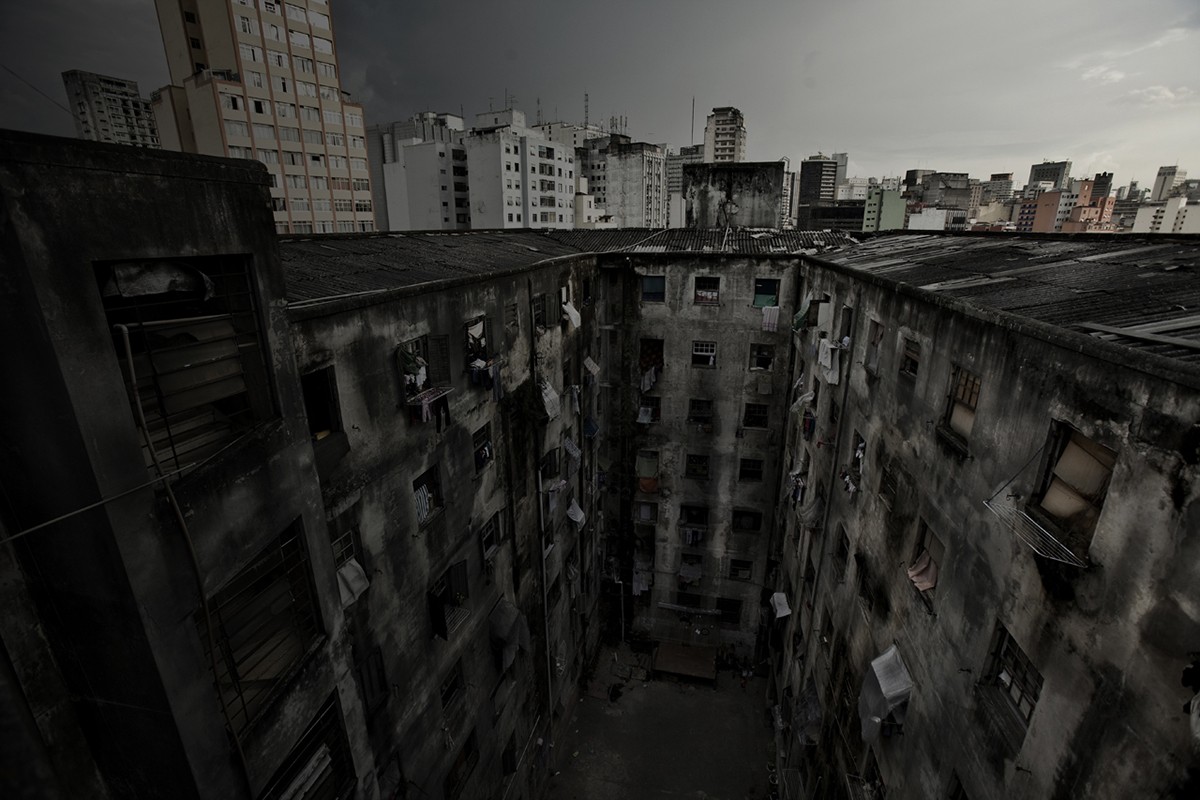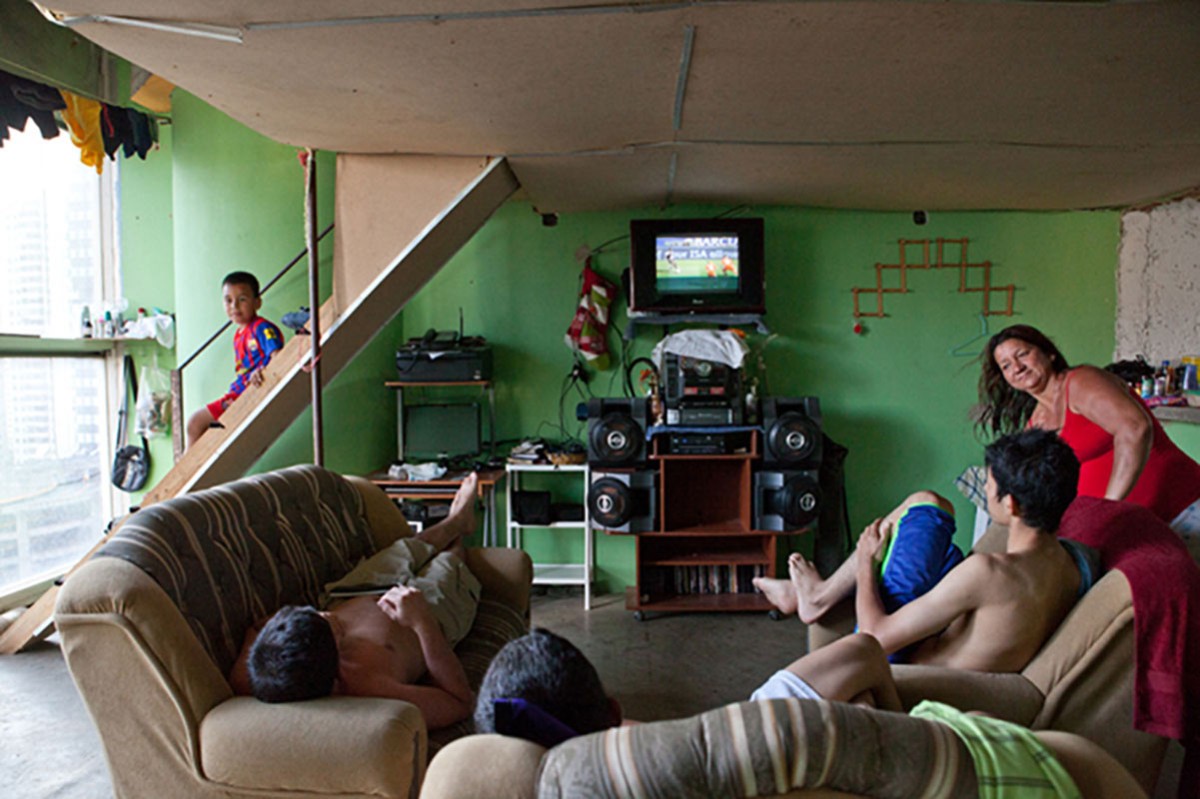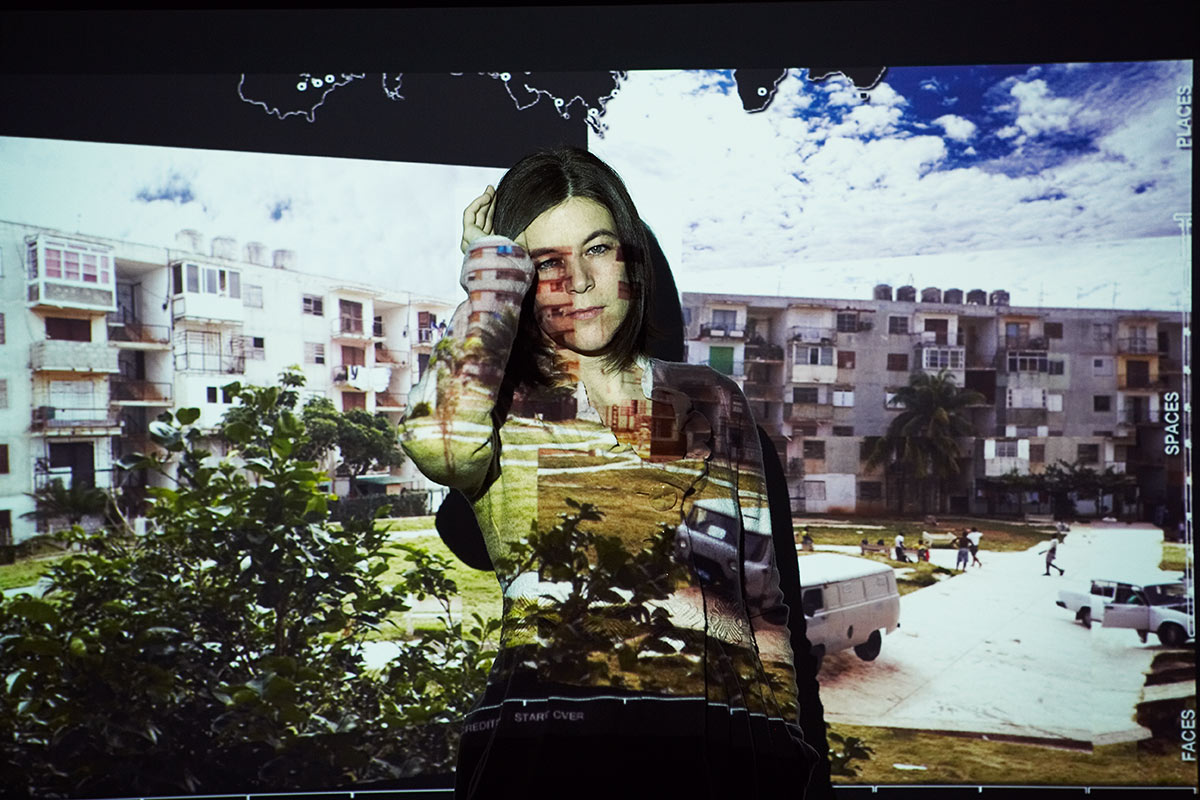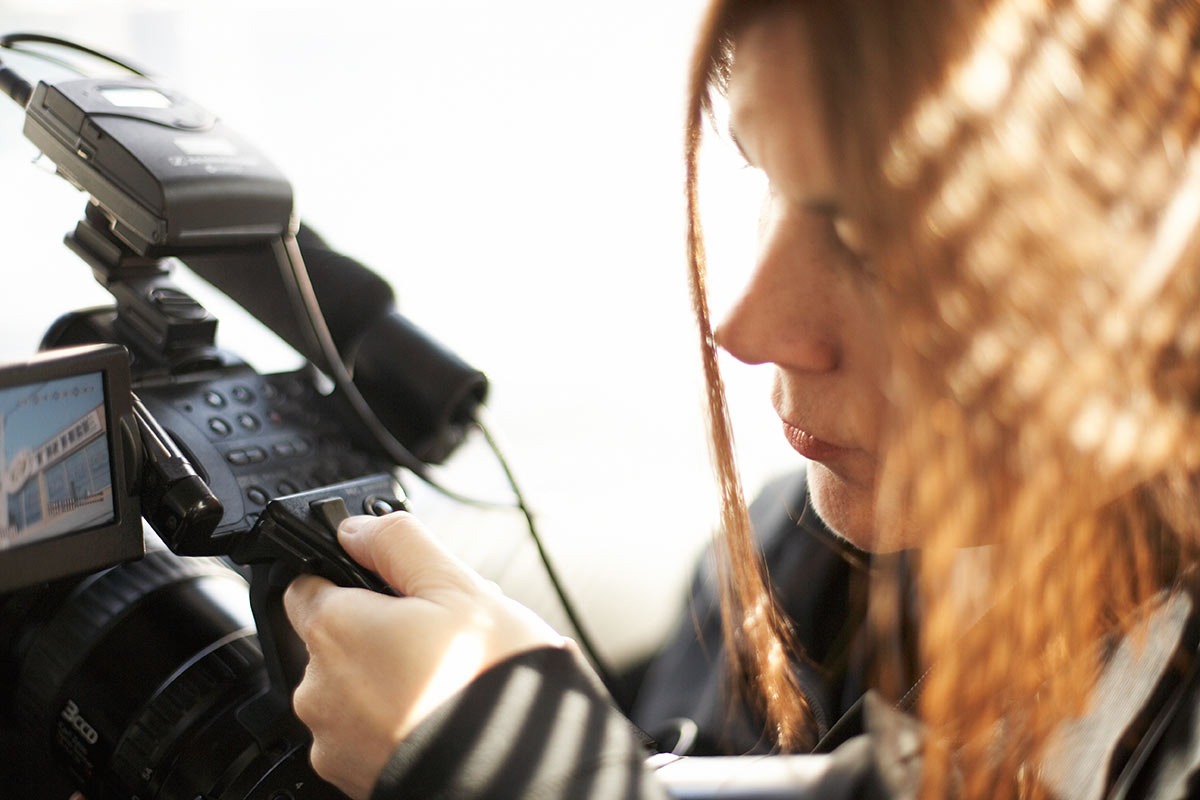Known for her Emmy award-winning multimedia project, Highrise, about life in residential skyscrapers throughout the world, documentarian Katerina Cizek recently completed a two-year residency at the MIT Open Documentary Lab and CAST. “I always think of the Highrise project as a storytelling prism. You can put anything through it, and it will all be connected somehow, but in unexpected ways,” Cizek explains.
The latest phase of the project, Highrise: Digital Citizenship, examines how new technologies and modes of communication shape residents’ personal and political lives. She premiered the final chapter of the acclaimed digital documentary project as a multimedia participatory event, Highrise: Universe Within, Live, at HotDocs, the Canadian International Documentary Festival, and later launched this pioneering project as a web documentary. At MIT, Cizek workshopped ideas for the live performance, “to take a web documentary and make it into a theatrical, meaningful, and cinematic experience on stage involving participatory elements with the audience.”
With a background in photojournalism, writing, film, radio and independent documentaries, Cizek claims to be “media agnostic” and avoids letting the technology alone drive the story. She says, “It’s a tricky question, story and technology and who leads whom, and I think when you let one lead over the other, often there is a failure in this kind of work. I think the key to a good project is to really have the wheels firmly on both tracks and not to let one get ahead of or behind the other.”
Cizek says that during her residency, MIT culture “touched every pixel” of Universe Within— from creative details, like basing the child’s voice for one of the avatars on MIT’s “Robot in Residence” to workshopping ideas with Scot Osterweil, Creative Director of the MIT Education Arcade, in the early phases of the project to having students user-test prototypes of the interactive architecture for the project.
“OpenDocLab has really have given a whole new renaissance to the relationship that MIT has with documentary,” Cizek says. “They’ve become key players in the documentary world and beyond, I think the digital world as well, by re-imagining and critically rethinking what documentary can and should be in terms of the interactive space.”
KATERINA CIZEK ON HER CO-CREATIVE PROCESS AND INTERACTIVE DOCUMENTARIES
Could you describe your documentary work, because it differs from what what somebody hearing the word “documentary” might think?
Sure, I define myself as a documentarian. I’ve made independent documentaries about international human rights, and for a long period in my life I had a specific focus on First Nation’s rights issues in Canada. I ran an independent production company, but then I got really interested in the web early on around 2000 and haven’t looked back since.
I’ve also really been interested in community-based methodologies—how to work with communities and make films or media projects with people rather than about them. I’m heavily inspired by the Challenge for Change Program at the National Film Board in the 60s and 70s, headed up by the legendary American documentarian, George Stoney. In that spirit, I’m really interested in how the technology of media can be used as a process of social change, not just a way to make a final product of a film.
I’m also interested in telling big stories that move the heart and move emotions and transcend language or geographic territories. How can a small story about one tennis court in North Toronto resonate to a worldwide audience on Wire.com? How do you make those connections? I really enjoy playing with what’s local and what’s global, and what’s global is really local.
How would you describe Highrise, as a whole, and the specific documentary you worked on during your MIT residency, Universe Within?
Highrise has been a six-year long project in which we’ve created over 20 iterations. Five or six of them are major documentaries that you can find online. Others are live installations or performances, or interventions in the subway, or specific performances at City Hall. Some people call it a series, but it’s not really a series in the sense that each item is not like the last one. That’s one of our mottoes—that we never do the same thing twice.
Universe Within is the final gesture, the final iteration and, again, it’s something that we’ve never really quite done before. It’s using WebGL technology [a Javascript API which allows you to create interactive 3D computer graphics], and we have used WebGL before, but not whole-hog; this is serious WebGL. We used connect camera DepthKit to film the hosts.
We used some of these techniques in Out My Window to research and collect stories from around the world, but a new element for me is to work with a fiction writer to develop the hosts and the narration and the linearity and the structure of the story. The final experience is quite different from anything we’ve done before in Highrise, but feels like a cousin, feels like it’s somehow related, and sheds new light, or refracts more light.
What projects occupied you the most during your time at MIT?
OpenDocLab and I applied to the visiting artist program with a specific project, which at that time was called “Digital Citizenship in the Global Suburbs,” and it started off as a relationship with two professors at University of Toronto, Deborah Cowen and Emily Paradis. They came with me on one trip to MIT to workshop the ideas behind what’s now known as Universe Within.
It was the research and development of that project that I worked on while at MIT; then the other half was to do some teaching and mentoring and getting to know the fellows and the graduate students within the OpenDocLab as well, so it was kind of a two part residency. I call it “experiential pedagogy” in the sense that I’m learning from the students as well, and they’re part of my process, so it’s like a really open concept of pedagogy and learning that I really think, if there’s one thing that I’ve learned the most from MIT, it is the possibility of that kind of culture being institutionalized. I always thought of that as something existing on the periphery of what’s possible in an institution. MIT, for me, embodies the possibility for that to be the mainstream, which is great.
In developing the project, you worked on a digital survey tool. Have you incorporated that into the final project?
Yes, the way that Universe Within started was as a digital citizenship survey tool. We created, or co-designed, a tool with residents of a highrise in Toronto to learn more about digital behaviors in that specific building. Then we became really interested in how to take that tool to other buildings around the world but also how might that survey become the backbone of the conversation that we have with our user within our own interactive documentary, of the user’s experience of the stories we tell?
Even though the survey itself has fallen away as an obvious structure in the piece that you see online, it’s been a really, really important part and scaffolding of the way that we’ve built Universe Within. We brought that survey to MIT numerous times and workshopped it. It’s this whole idea of developing the perfect question. What is the question that’s going to unlock the key to somebody’s story or to somebody’s ability to have agency in their world, and that’s what I struggle with as an artist throughout my working life, and it’s certainly central to this project—highlighting the question. What is the question that you ask that makes it all unfold?
Universe Within previews as a live improvisational performance at Hot Docs. Is this your first time working with live performance, and is this something that you see yourself continuing to do?
In previous iterations of Highrise, I’ve done live performances. With Out My Window, for example, I’ve done a live VJ where I’m on stage and I’m just walking through the project and it’s being projected writ-large on the big cinema screen. I’ve also done that with live musicians. I’ve taken away the playlist that is on the website and instead had musicians develop a score specific for that evening. I’ve done that in Montreal with a group of musicians, and I’ve also done that with musicians in Toronto for an evening to celebrate Glenn Gould, and so I ended up working with a pianist who played on Glenn Gould’s piano, Steinway, so that was a wonderful highlight. In fact, those are the two musicians I’ve worked with on Universe Within.
The music of Universe Within is built on the live performance that we created for Out My Window. It was interconnected, and then we’ve also done an installation, an art gallery installation, of Out My Window, so I’ve done a little bit of that kind of stuff, but I would say nothing quite like this. This is very performative; this has a host and an actor on stage navigating us through the material in much the same way as what we’re doing in the documentary. For sure there’s a much stronger movement towards questioning the constructive nature of a documentary in this work.
This is a highly collaborative project. Does co-creation give you any directorial anxiety about having your vision realized?
I think there’s a tendency to polarize authorship and collaboration and that somehow you can’t have one and the other, and while I agree that there are distinctions to be made between them, I have a pretty strong set of parameters in the way that I tend to co-create. One of the primary tenets of that is that you work and respect each other’s expertise. When I work with people who have first-lived experience of an event or a phenomenon, their first-lived experience has a primacy to it, but in terms of making media, I claim that expertise. I’ve done it before and I kind of know what I’m doing; I’m still learning along the way. And I think coming from a place of respecting each other’s strengths and weaknesses is a much more transparent and honest way of working collaboratively, so that we’re not claiming that everybody’s making every decision by consensus all the time. That’s not what collaboration is; that’s disaster. That’s a disaster in the making. It’s not about voting on everything all the time with a committee and then having everything leveled out to what the general population wants on a project. So, it’s a much more nuanced and complex way of working.
What would you advise people who are where you were two years ago, about to start their residency with the OpenDocLab and with CAST?
Oh, it’s an incredible, incredible opportunity and experience. I guess it’s a balance of not feeling too overwhelmed by the incredible multiplicity of possibility and then just doing your research and following your gut in terms of who to meet and what to do. And, stay very iterative. Trust that the people whom you meet can have a really big impact on the work that you do; I think that that’s the greatest gift that MIT gives.
This post is the first in an ongoing series of interviews with CAST Visiting Artists, in which they share aspects of their artistic processes and the stories behind the works they developed at MIT.




